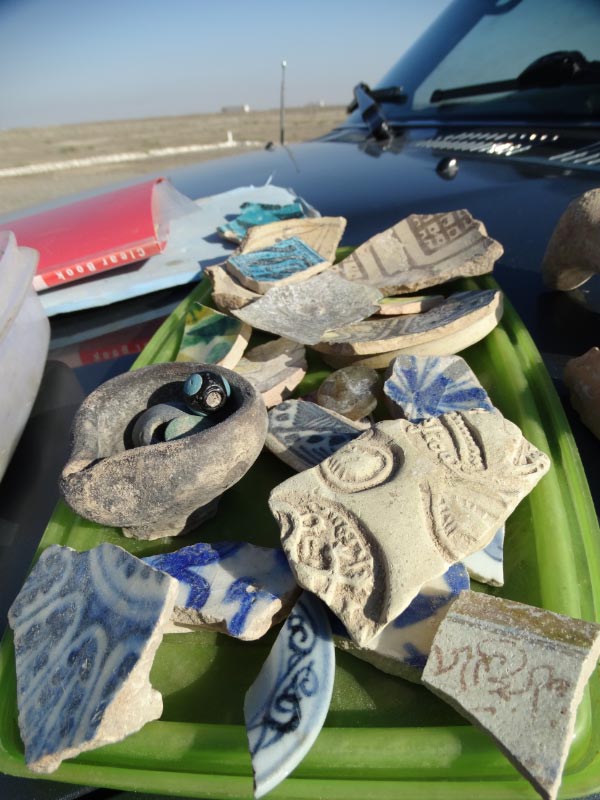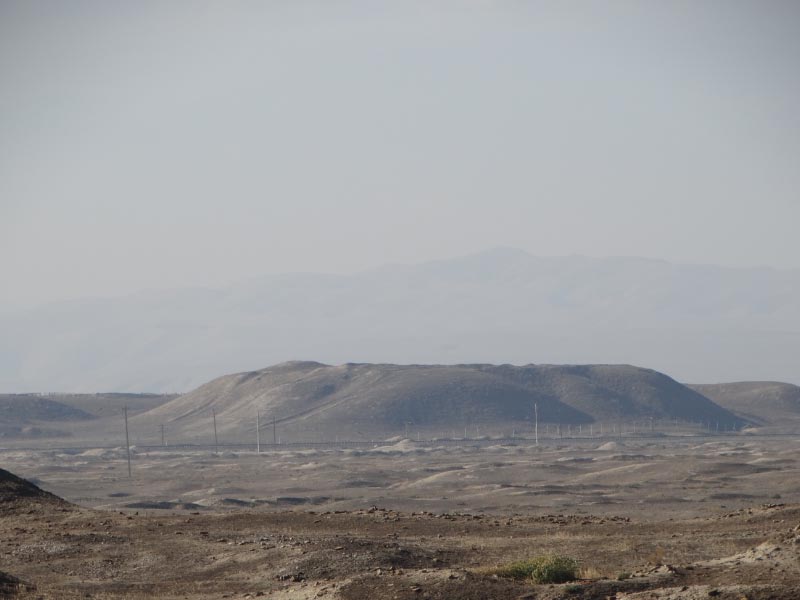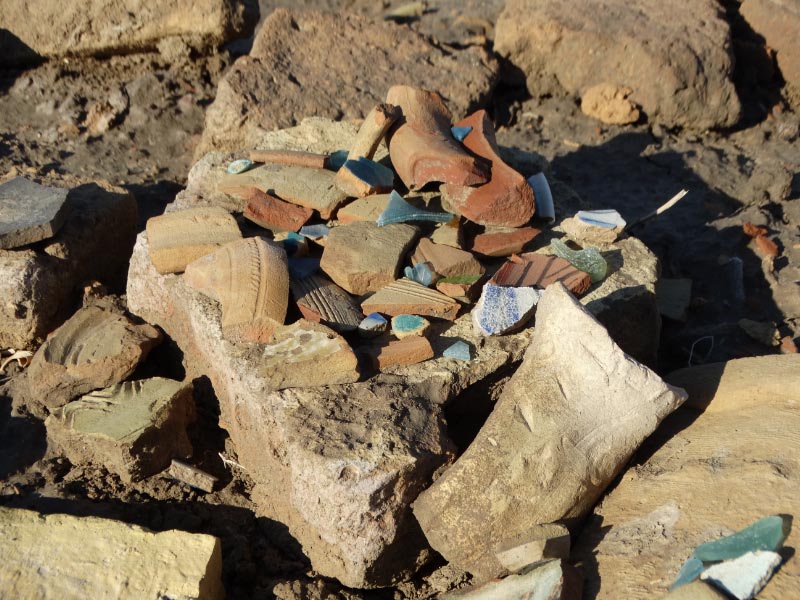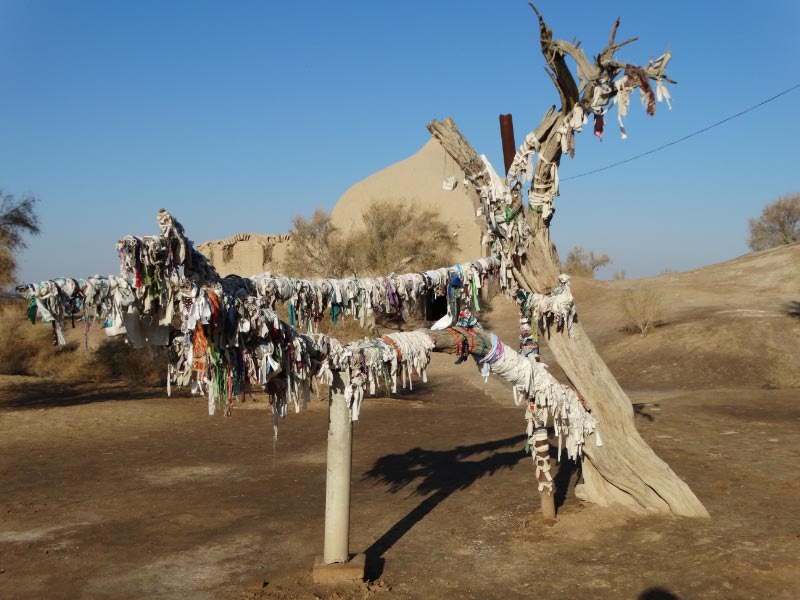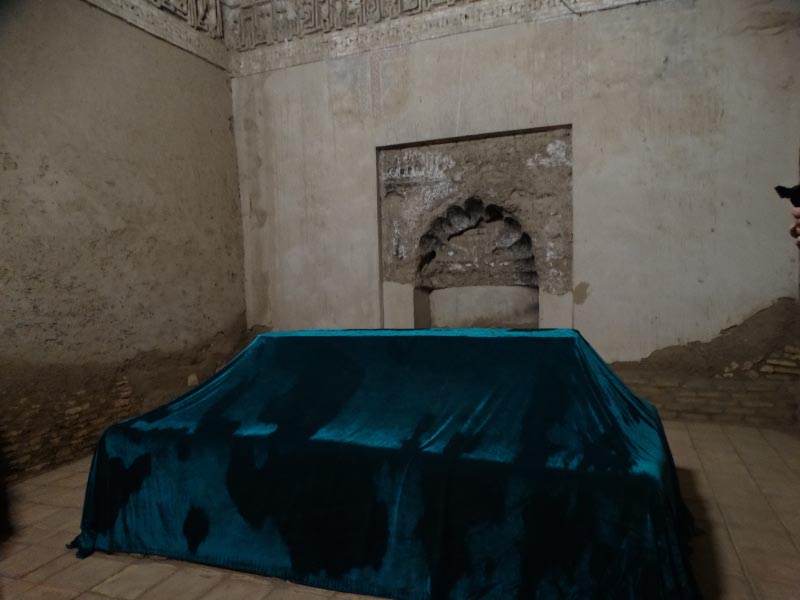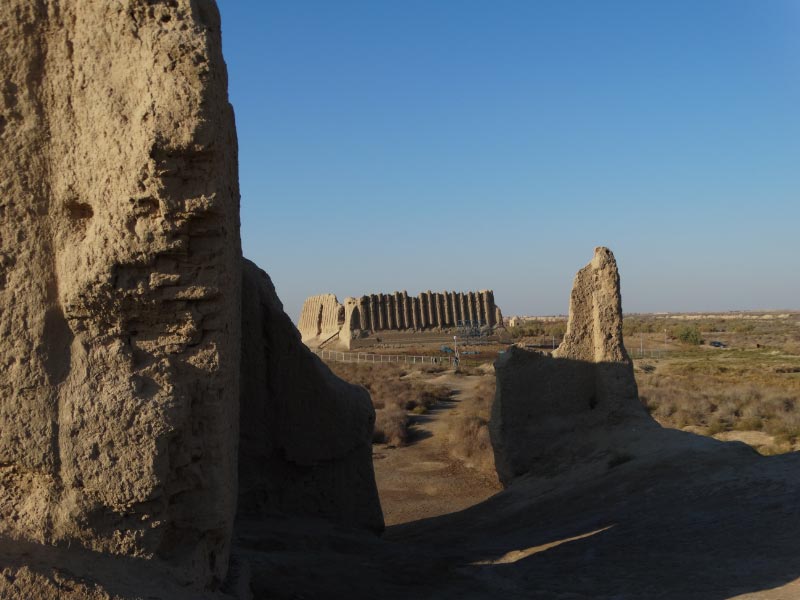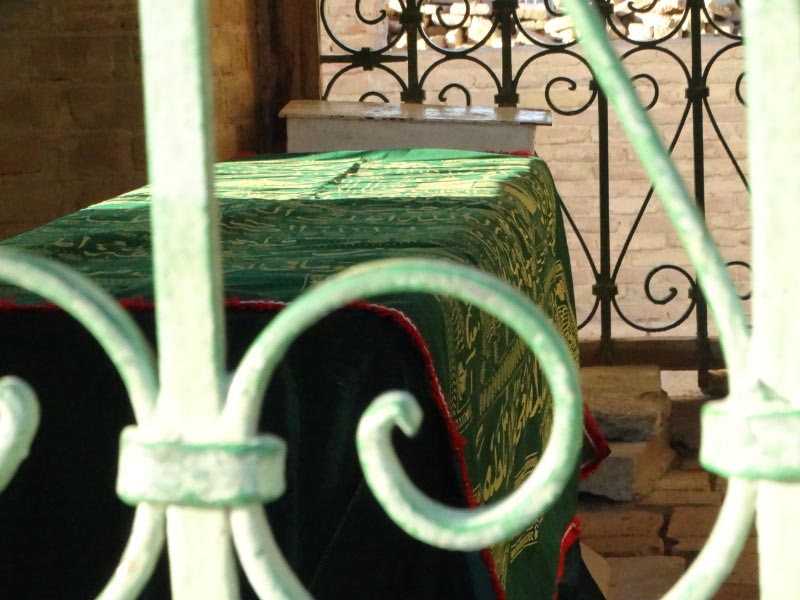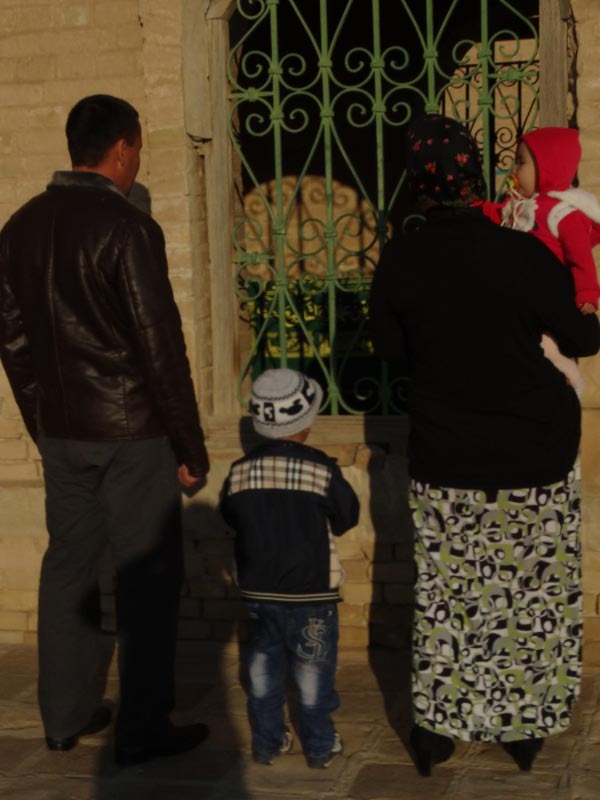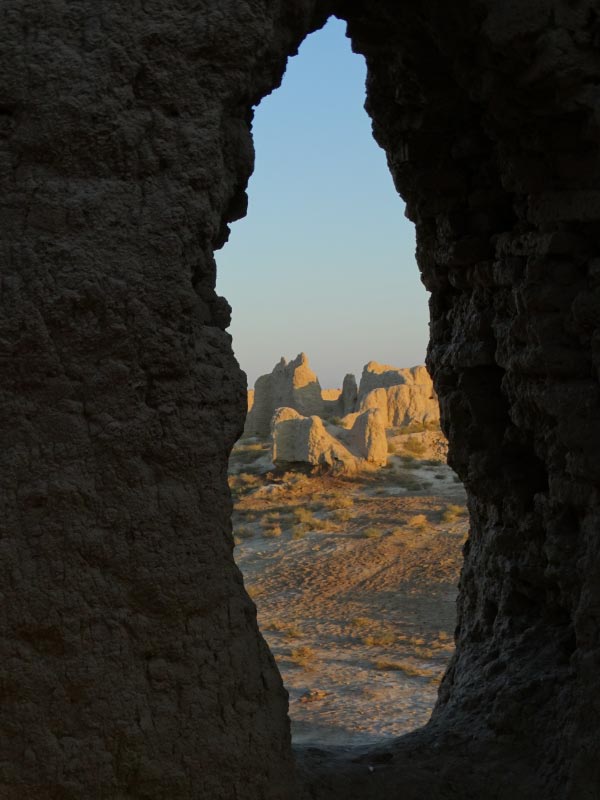Wednesday 29 October
It would appear that the country’s wealth has been lavished on the extravagances of Ashgabat’s marble, glass and water but not on roads. The drive to Mary was long and arduous, with the road alternating between falling apart and needing repair. Some roadworks were in place and we alternated between the new incomplete road and the old. This major highway which links Ashgabat to the east was full of trucks, local, Turkish, Iranian and Afghan. Old cars, not considered roadworthy in most developed countries, and fast Toyota’s made up the rest of the road traffic.
It is normal to take the best path of the road, which means travelling on the verge or wending your way between the potholes regardless of which side of the road they are on.
We passed kilometres of cotton, wheat and corn fields on the journey that took us alongside the Karakum Canal, Turkmenistan’s lifeblood.
The overworked soil is evident with salt sitting on top in many places.
We stopped at the site of the middle age town Arbervid and clambered around the ruins of the citadel and parts of the old town. The ground was littered with pottery and tiles, remnants of the ancient life. Our guide, Oleg explained that archaeologists weren’t interested in the site as it is not old enough.
Oleg than showed us his personal collection of artefacts that he had picked up on his travels. He had children’s toys, brass and ceramic objects hundreds and even thousands of years old – the sort of stuff you find in museums.
In the distance was a mound where a village Namuzga Depa of approx 4000 people lived approx 4000BC. Other than a similar place in Turkey it is considered to be one of the oldest larger cities of its time. At that time people generally lived together in groups of 150 to 200 people.
Our time in Mary was shorter than planned as we were crossing the Iranian border on a Friday and they had asked for us to be there before Friday prayers at 1pm.
So as we arrived in Mary we continued to the archaeological site of Merv. It is an amazing site as each city has been built on a different site, leaving remnants of previous cities. Wikipedia best descrips it:
Merv’s origins are prehistoric: archaeological surveys have revealed many traces of village life as far back as the 3rd millennium BC and that the city was culturally part of the Bactria-Margiana Archaeological Complex. Under the name of Mouru, Merv is mentioned with Balkh in the geography of the Zend-Avesta (commentaries on the Avesta). Under the Achaemenid dynasty Merv is mentioned as being a place of some importance: under the name of Margu it occurs as part of one of the satrapies in the Behistun inscriptions (ca. 515 BC) of the Persianmonarch Darius Hystaspis. The first city of Merv was founded in the 6th century Merv’s origins are prehistoric: archaeological surveys have revealed many traces of village life as far back as the 3rd millennium BC and that the city was culturally part of the Bactria-Margiana Archaeological Complex. Under the name of Mouru, Merv is mentioned with Balkh in the geography of the Zend-Avesta (commentaries on the Avesta). Under the Achaemenid dynasty Merv is mentioned as being a place of some importance: under the name of Margu it occurs as part of one of the satrapies in the Behistun inscriptions (ca. 515 BC) of the Persianmonarch Darius Hystaspis. The first city of Merv was founded in the 6th century BC as part of the expansion into the region by the Achaemenid Empire[2] of Cyrus the Great (559–530 BC), but the Achaemenid levels are deeply covered by later strata at the site.
Alexander the Great’s visit to Merv is merely legendary, but the city was named Alexandria (Ἀλεξάνδρεια)[3] for a time. After Alexander’s death, Merv became the capital of the Province of Margiana of the Seleucid, Parthian, and Sassanid states. Merv was renamed Antiochia Margiana by the Seleucidruler Antiochus Soter, who rebuilt and expanded the city at the site presently known as Gyaur Gala (Turkish Gayur Kala) (Fortress). It was ruled in succession by Bactria, Parthia, and the Kushans after the fall of the Seleucid dynasty. It was a major city of Buddhist learning for many centuries until its Islamicization. (Use Wikipedia) Alexander the Great’s visit to Merv is merely legendary, but the city was named Alexandria (Ἀλεξάνδρεια)[3] for a time. After Alexander’s death, Merv became the capital of the Province of Margiana of the Seleucid, Parthian, and Sassanid states. Merv was renamed Antiochia Margiana by the Seleucidruler Antiochus Soter, who rebuilt and expanded the city at the site presently known as Gyaur Gala (Turkish Gayur Kala) (Fortress). It was ruled in succession by Bactria, Parthia, and the Kushans after the fall of the Seleucid dynasty. It was a major city of Buddhist learning for many centuries until its Islamicization
After the Sassanid Ardashir I (220–240 AD) took Merv, the study of numismatics picks up the thread: a long unbroken direct Sassanian rule of four centuries is documented from the unbroken series of coins originally minted at Merv. During this period Merv was home to practitioners of various religions beside the official Sassanid Zoroastrianism, including Buddhists, Manichaeans, and Christians of the Church of the East. Between the 6th (553) and 11th centuries AD, Merv was the seat of an East Syrian metropolitan province. Sassanid rule was briefly interrupted by the Hephthaliteoccupation from the end of the 5th century to 565 a.d.
The sun was getting low as we visited the ancient sites.
Mohammed bin Zeid who died in battle in the 8th century was considered an important person by the 12C. Although both his head and body were lost, the mausoleum is an important place to remember him and make a pilgrimage to ask him for special favours. A wishing tree in front of the mausoleum held ribbons, baby cribs and dummies tied to it.
Our next stop was the ruins of Big Kyz Kala & Little Kyz Kala Fortresses, built in the 7th century and used for another 600 years. The larger building was sealed off for archaeological works however we were able to clamber over the smaller building and imagine how rooms with tiny or no windows might have been used 1300 years ago.
Another important pilgrimage site for Turkmenistan is the mausoleums of two Islamiv askhab (companions to the prophet) Al-Hakim ibn Amr Al-Jafari and Buraida ibn Al-Huseib Al-Islami. In amongst the ruins, this 15th century complex was built 800 years after the askhabs died.
We then visited the enormous mausoleum of Sultan Sunjar who died in 1157 of a broken heart when he returned from captivity to find his beloved Merv pillaged by Turkic nomads. Stories are told that the bright blue dome of this mosque could be seen a day’s journey away, perhaps 28-32km on the Silk Road. Camel trains trekked for three days and rested for one day. To support the Silk Road travellers, caravanserai were generally found about 90km apart for the rest day.
We then saw the mausoleum in twilight and its upper windows were lit up, once again a beacon in the desert.
We visited a building without a name. It’s purpose is unclear
It was long and narrow with no windows and a small door. Perhaps a ceremonial place, or a library or even a pigeon coop. The secrets of history.
We climbed to the top of the old watch tower to watch the sun set. It provided a lovely view over the smaller Erk Kala fortress from the 6th centuryBC, and the surrounding area.
Oleg’s passion for history & archaeology was well displayed when we visited a brand new excavation of one of the walls. You could clearly see how the wall had developed over the ages, starting from the 6th centuryBC. Then the Greeks came and extended it followed by various other invaders. Different inhabitants can be identified by the size of the bricks used to construct the wall. Earlier inhabitants used larger bricks.
Our last stop was to see a giant ice house, built during the Timurid era. Frozen snow could be kept for up to two and a half years. We had seen a similar but younger ice house in Olite in Spain.
It was a very long day and we appreciated a not so cold beer with dinner.
e_header.jpg)

